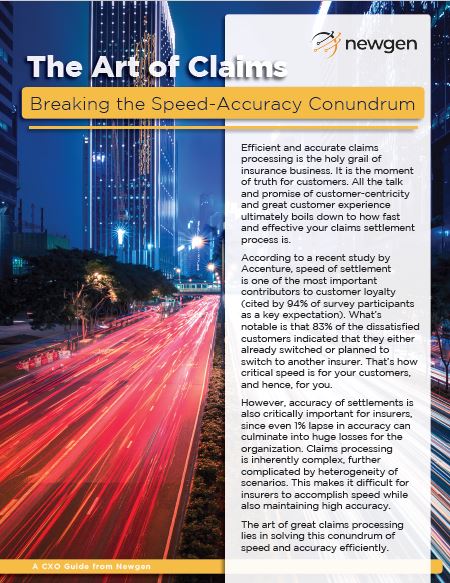Why Claims Processing Defines Customer Experience?
In insurance, claims are the “moment of truth.” All the promises about protection and service come down to how fast and accurately you settle a claim. Speed matters for loyalty Accenture reports that 94% of policyholders say fast claims settlement is a key expectation, and 83% of dissatisfied customers either switch or plan to switch providers.
But accuracy matters just as much. Even a 1% lapse can lead to significant financial loss and compliance risk. The challenge? Claims are inherently complex, involving diverse scenarios, multiple stakeholders, and extensive documentation. Traditional manual and paper-heavy processes make it difficult to achieve both speed and precision.
This whitepaper explores how insurers can break the speed-versus-accuracy conundrum by adopting intelligent automation, digital document management, and end-to-end claims orchestration.
Why Claims Get Stuck The Speed & Accuracy Problem?
Barriers to Speed
- Manual Processes: Heavy reliance on paperwork and human effort slows everything down and drives up costs.
- Weak Third-Party Integration: Collaboration with garages, investigators, or service providers is often done through emails and offline communication, delaying resolution.
- Siloed Systems: Claims touch multiple departments, but disconnected platforms cause inefficiencies and lack of visibility.
- Unintegrated Digital Channels: Customers want to initiate and track claims via social or mobile, but most insurers can’t embed these channels effectively.
Barriers to Accuracy
- Limited Process Controls: Without smart routing, complex cases may be handled by the wrong teams, increasing errors.
- Poor Audit Strategy: Manual checks and weak rules management limit continuous improvement.
- Paper-Intensive Workflows: Lost or hard-to-retrieve documents hurt accuracy and cause rework.
- Data Gaps: Fragmented and manually entered data creates blind spots and inconsistencies.
Breaking the Conundrum A Digital-First Approach
To achieve both speed and accuracy, insurers must treat claims as a connected, paperless, and intelligent process rather than isolated tasks. Here’s how to get there:
- Automate the Workflow
Create a connected claims journey from initiation to settlement with full visibility. Automation identifies bottlenecks, speeds hand-offs, and provides real-time status tracking.
- Automate Rules & Decisions
Use a rules engine to handle routine, structured decisions and escalate only complex exceptions to human experts. This improves accuracy while speeding up straightforward claims.
- Enable Straight-Through Processing (STP)
Integrate all underlying systems policy admin, billing, external partners to reduce manual data transfers. Build interfaces for garages, surveyors, and third parties to share documents in real-time.
- Digitize Documents
Adopt a robust Enterprise Content Management (ECM) system to capture, tag, index, and store claim documents centrally. Dynamic checklists and digital records improve accessibility and compliance.
- Embed Multi-Channel Communication
Let customers initiate claims via apps, social media, or web portals with photos, videos, or forms. Provide automated, multi-channel status updates to keep them engaged and reduce inbound calls.
- Build Flexibility With Dynamic Case Management
Handle unique scenarios better by allowing ad-hoc routing, real-time collaboration, and exception handling without breaking the core automated flow.
- Future-Proof With BPM & RPA
Use Business Process Management (BPM) to keep processes adaptable as business and regulations change. Layer Robotic Process Automation (RPA) for high-volume, rule-based tasks like data entry and claim validation.
Business Impact of Modern Claims Processing
Organizations that have adopted this digital-first approach report:
- Faster claim resolution times up to 50% improvement.
- Higher accuracy rates with fewer costly errors and rework.
- Improved customer satisfaction and retention due to timely, transparent updates.
- Lower operational costs by reducing manual effort and optimizing resources.
- Better compliance and audit readiness with digital records and end-to-end tracking.
How Newgen Powers Next-Gen Claims?
Newgen’s AI-enabled Claims Processing Platform helps insurers master both speed and accuracy with:
- Unified digital workflow from FNOL (First Notice of Loss) to settlement.
- Smart decision automation with configurable business rules.
- Advanced document management and dynamic checklists.
- Seamless third-party and channel integration for frictionless collaboration.
- AI & RPA-powered processing to handle large volumes with consistency.
Trusted by global insurers, Newgen helps accelerate claims turnaround, control costs, and deliver experiences that build trust and loyalty.
Why Acting Now Matters?
Insurtechs and digital-native players are already setting new benchmarks for speed, transparency, and customer delight. Legacy processes will not survive this shift. Insurers who digitize claims can reduce leakage, improve retention, and compete with agile disruptors.
Start Your Claims Transformation
If your claims process is slow, error-prone, or frustrating for customers, it’s time to modernize.

